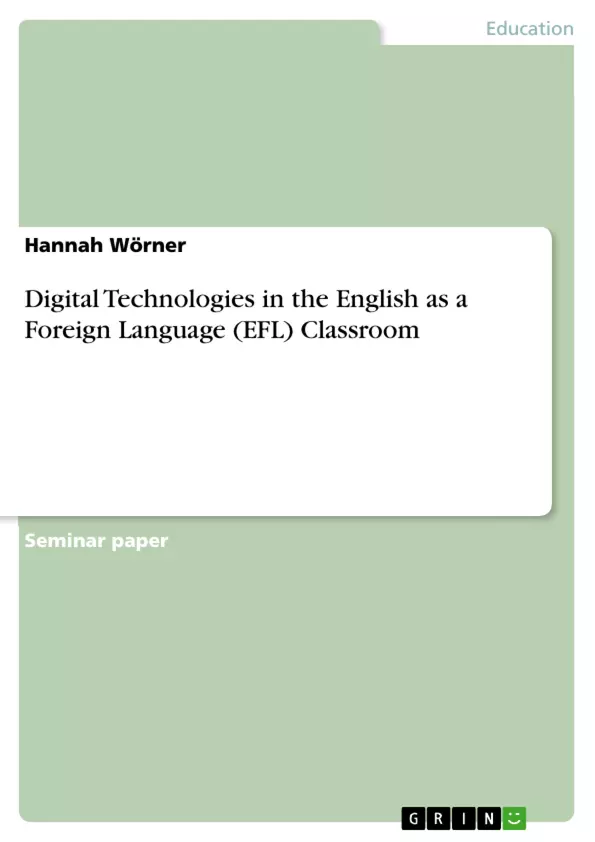How can the two fields of English as a foreign language, further referred to as EFL, and the usage of Digital Technologies (DT) in school be possibly combined and why should there be a correlation between learning English and using DT? In the following term paper, this question will be investigated carefully. After that, there will also be an example of a concrete lesson in the EFL classroom using DT and in the end there will be a reflection of this seminar.
The KIM study 2018 shows that out of 1.231 participants in the age of 6 to 13, 98% have access to the internet and 97% of them own a smartphone. This means, that nearly everybody is in daily contact with Digital Media, even children in primary school. First of all, there needs to be a differentiation between Digital Media and Digital Technology. The term Digital Media includes created products and the digital tools which were used to produce them, while it also includes the transport of information. Digital Technologies is a more generic term which includes everything covered by Digital Media. Therefore, Digital Technologies are composed by digital devices like tablets, computers or smartphones as well as digital resources, which provide information of any kind in a digital format. That is why in the following it will only be referred to the term of Digital Technologies and not Digital Media.
Just like Digital Technologies, in the following described as DT, the English language plays an important role in many people's lives as well. English is not only the language spoken by the most people all over the world but also the one which is geographically distributed most widely. In most of these countries, English is the official language, while in other countries it is used for educational or business purposes. Because of its importance, it is crucial for young students to learn English as a foreign language in school. Before reaching the age of 10, a time frame which is called “window of opportunity” emerges, in which children tend to be most receptive regarding language learning. Through English lessons in primary school, the school system uses this opportunity. According to Maras and Ametsbichler the English lessons should follow a competence orientation, which means that it should provide many opportunities to foster competencies like listening, speaking, reading, writing, speech acting, method related competencies as well as intercultural competencies.
Inhaltsverzeichnis (Table of Contents)
- Discussion of Digital Technologies in the EFL classroom
- The Importance of English and Digital Technologies
- Digital Technologies in Schools
- Strengths and Weaknesses of Digital Technologies
- Learning Environments for Learners with Special Educational Needs
- Content of Lessons
- Grammar and Vocabulary
- Feedback
- Spoken and Written Communication
- Ethical Aspects
- Weaknesses
- Conclusion
- Using Digital Tools in the EFL classroom
- Works Cited
Zielsetzung und Themenschwerpunkte (Objectives and Key Themes)
This term paper examines the potential for integrating digital technologies (DT) into the English as a Foreign Language (EFL) primary classroom. It explores the significance of both English and DT in modern society, highlighting the need for schools to leverage these tools for authentic learning environments. The paper further investigates the potential benefits and challenges of using DT to support learners with special educational needs (SEN).
- The importance of English as a global language and digital technology in contemporary society.
- The challenges and opportunities of incorporating DT into the EFL classroom.
- The potential of DT to create authentic learning environments and cater to individual learning needs.
- The impact of DT on learners with SEN, including both its benefits and limitations.
- The need for teachers to develop expertise in using DT effectively and responsibly in the classroom.
Zusammenfassung der Kapitel (Chapter Summaries)
The first chapter explores the importance of both English and Digital Technologies in the lives of students. It highlights the widespread access to digital media and discusses the need to prepare students for a digitized world. The chapter also examines the potential of using DT to create engaging and effective EFL learning environments.
The second chapter delves into the specific challenges and opportunities of integrating DT into the EFL classroom. It discusses the need for a pedagogical approach that utilizes DT as a tool to support learning, rather than an end in itself. The chapter also highlights the importance of teacher training and professional development to ensure effective implementation of DT in the EFL classroom.
The third chapter focuses on the strengths and weaknesses of DT for supporting learners with SEN. It explores the potential of DT to create personalized learning environments and provide individualised support. The chapter also addresses the limitations of DT, such as the need for extensive teacher knowledge and the financial costs associated with acquiring and maintaining specialized technologies.
Schlüsselwörter (Keywords)
This term paper focuses on the key concepts of English as a Foreign Language (EFL), digital technologies (DT), authentic learning environments, learners with special educational needs (SEN), and assistive technology. It examines the potential of integrating DT into the EFL primary classroom to create engaging, effective, and inclusive learning experiences for all students.
- Quote paper
- Hannah Wörner (Author), 2020, Digital Technologies in the English as a Foreign Language (EFL) Classroom, Munich, GRIN Verlag, https://www.grin.com/document/984856



